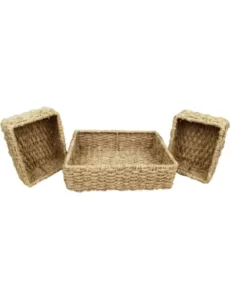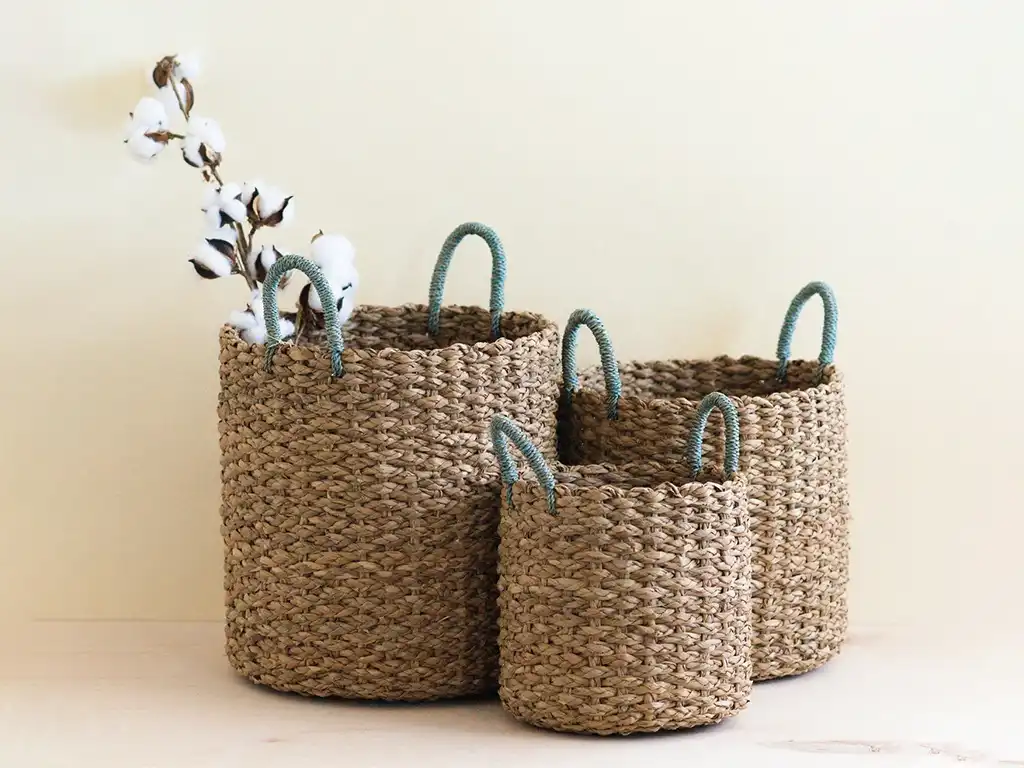Bangladesh, with its lush landscapes and abundant natural resources, is home to a rich tradition of crafting seagrass baskets. These eco-friendly and aesthetically pleasing products not only embody the beauty of nature but also reflect the craftsmanship and cultural heritage of the artisans. In this article, we will explore the origin, making, uses, and cultural significance of seagrass baskets in Bangladesh.
The Origin and History of Seagrass Baskets in Bangladesh
Early Beginnings of Basket Weaving
Basket weaving is one of the oldest crafts in human history. In Bangladesh, this tradition dates back centuries, with seagrass baskets emerging as a popular and sustainable product. The humid and fertile river deltas of Bangladesh have provided an ideal environment for the growth of seagrass, which has been harvested and woven into baskets by local communities for generations.
The Evolution of Seagrass Baskets
Over the years, the craft of basket weaving has evolved, influenced by cultural exchanges, trade, and technological advancements. While traditional designs remain popular, artisans have also embraced contemporary patterns, leading to a fusion of old and new in seagrass basket designs.
The Craftsmanship Behind Seagrass Baskets
The Harvesting of Seagrass
Seagrass is harvested from coastal and riverine areas, particularly in the southern regions of Bangladesh. This natural material is abundant and renewable, making it an environmentally sustainable choice. The harvesting process is often done manually, with care taken to ensure the long-term health of the seagrass beds.
The Weaving Process

The weaving of seagrass baskets is a meticulous process that requires skill and patience. Artisans use traditional techniques passed down through generations, often working in small cooperative groups. The seagrass is dried and treated before being woven into various shapes and sizes of baskets.
Tools and Techniques Used in Weaving
The tools used in weaving seagrass baskets are simple but effective. A sharp knife, wooden frame, and basic measuring tools are commonly used. The techniques vary depending on the design and purpose of the basket, with different weaving patterns creating different textures and strengths.
The Various Uses of Seagrass Baskets
Functional Uses in Daily Life
Seagrass baskets are incredibly versatile and can be used in various ways in daily life. They are commonly used for storage, as laundry baskets, planters, and even as decorative items. Their natural look and durability make them a favorite choice for households.
Artistic and Decorative Purposes
Beyond their functional uses, seagrass baskets have found a place in the world of art and interior design. Their natural texture and earthy tones add a rustic charm to any space, making them popular in modern home decor.
Customization and Personalization
Many artisans offer customized seagrass baskets, allowing customers to choose specific designs, colors, and sizes. This personalization adds a unique touch, making each basket a one-of-a-kind piece.
The Cultural Significance of Seagrass Baskets in Bangladesh
A Symbol of Sustainable Living
In a world increasingly focused on sustainability, seagrass baskets symbolize eco-friendly living. The use of natural materials and traditional methods reflects a commitment to preserving the environment while supporting local communities.
Supporting Artisans and Local Economies
The production of seagrass baskets is more than just a craft; it is a vital source of income for many rural families in Bangladesh. By purchasing these baskets, consumers are supporting artisans and helping to sustain local economies.
Women’s Empowerment Through Craftsmanship
In many areas of Bangladesh, basket weaving is a craft predominantly practiced by women. The income generated from selling seagrass baskets empowers women, giving them financial independence and contributing to gender equality in the region.
Challenges and Opportunities in the Seagrass Basket Industry
Environmental and Economic Challenges
While the demand for seagrass baskets is growing, the industry faces challenges. Environmental factors, such as climate change and pollution, threaten seagrass habitats. Additionally, economic challenges, including competition from synthetic alternatives, pose risks to the traditional craft.
Opportunities for Growth and Innovation
Despite these challenges, there are numerous opportunities for growth in the seagrass basket industry. Innovations in design, marketing, and sustainable practices can help expand the market, both domestically and internationally.
The Role of Government and NGOs
Government support and initiatives from non-governmental organizations (NGOs) play a crucial role in preserving and promoting the seagrass basket industry. Training programs, financial assistance, and awareness campaigns can help overcome the challenges and create a brighter future for artisans.
The Future of Seagrass Baskets in Bangladesh
Sustainability and Global Trends
As global awareness of environmental issues grows, there is increasing demand for sustainable products like seagrass baskets. This trend offers hope for the future of the industry, with potential for expansion into new markets.
Preservation of Traditional Craftsmanship
The preservation of traditional craftsmanship is essential for the survival of the seagrass basket industry. Efforts to document and teach these skills to younger generations will ensure that this beautiful craft continues to thrive in the years to come.
Conclusion: The Enduring Appeal of Seagrass Baskets
Seagrass baskets from Bangladesh are more than just functional items; they are a testament to the beauty of nature, the skill of artisans, and the importance of sustainable living. As the world embraces eco-friendly products, these baskets are poised to become a symbol of both tradition and innovation, connecting the past with the future.

